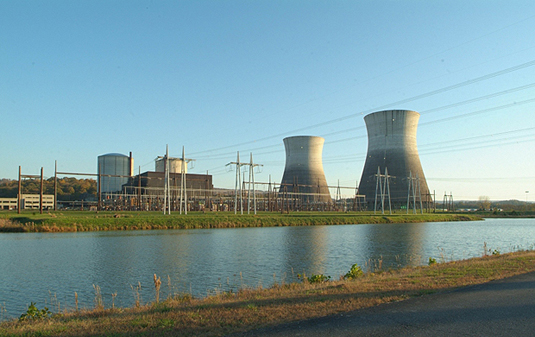| |
TVA facing one of greatest financial gambles in its history
Published August 10, 2011, 11:50 a.m.

Bellefonte Nuclear Plant -- located along the banks of the Tennessee River's Guntersville Reservoir, less than 10 miles from Scottsboro, AL and 110 miles southeast of Nashville, TN. Tennessee Valley Authority |
KNOXVILLE -- The TVA Board will be voting August 18, 2011 on whether to complete construction of a 40 year old Bellefonte nuclear reactor in Alabama.
According to a report prepared by an expert engineer for Southern Alliance for Clean Energy (SACE), there are 7 major roadblocks, including water damage to the reactor site foundation, compromised radiation containment in the unfinished reactor, and a lack of records about what exactly went on when the critical systems in the unfinished plant were cannibalized while the project lay dormant.
SACE says that "TVA will be making a 'bad nuclear bet' if it gambles billions of dollars on completing the almost 40-year-old Bellefonte nuclear plant project."
Fairewinds Associates, Inc.'s chief engineer Arnold Gundersen prepared the report for SACE. Gundersen is a nuclear engineer with more than 39 years of nuclear industry experience and oversight including being a former senior vice president nuclear licensee and reactor operator.
Gundersen's expert analysis identified seven specific areas of risk, which in Fairewinds' opinion will cause further delays, additional costs and even possible suspension of the Bellefonte project if TVA decides to move forward with its construction. The key areas of concern are: (1) Bellefonte's unique reactor design that lacks substantial worldwide operational history; (2) groundwater intrusion that is weakening the reactor site's foundations; (3) missing critical nuclear Quality Assurance documents and incomplete records; (4) cannibalization of Bellefonte's mechanical systems for small amounts of cash; (5) Bellefonte's unique containment deficiencies; (6) historical precedents that don't support TVA's decision; and (7) costly post-Fukushima safety implementations.
TVA spokesman Ray Golden said "TVA has spent considerable time and effort in its analysis of the Bellefonte site. Based on that review, the TVA staff concluded that completing the Unit 1 reactor is TVA's best option for Bellefonte."
SACE disagrees with TVA saying, "If the Bellefonte reactors are built and become operational, integral components will already be decades old and will likely already be suffering degradation that could compromise the safety of the facility."
Stephen Smith, executive director, Southern Alliance for Clean Energy, said: "TVA is possibly about to embark on one of the greatest financial gambles in the history of the agency. The history of the Tennessee Valley Authority's (TVA) Bellefonte site in Jackson County, Alabama is unique and complicated spanning nearly forty years. A total of four reactors have been proposed and billions of dollars have been spent, but none have ever been fully constructed and not a kilowatt of electricity has ever been produced. The Southern Alliance for Clean Energy has serious concerns about TVA's push to complete the mothballed, abandoned Bellefonte reactors. Given the damage to the containment vessel at Bellefonte, which is similar to the damage and ongoing problems to the containment vessel at Progress' Crystal River plant, this new information in the report coupled with Bellefonte's troubled history leads us to believe that TVA should not go forward with completion of the reactor at Bellefonte. This report documents those concerns and makes a strong case to the TVA Board that finishing Bellefonte is not a gamble worth taking."
Gundersen said: "In the aftermath of the significant tragedy at Fukushima many lessons learned are coming to light. Three out of three Fukushima containment systems failed to contain radioactivity and failed to hold their strength as the reactor went through the substantial stresses of a design-basis accident. This series of accidents has fundamentally altered the risk assessment scenario upon which licensing and operation of nuclear power plants are predicated. Prior to the Fukushima accidents, the Nuclear Regulatory Commission (NRC) assumed that there was no likelihood that containment could ever fail. The energy releases from three hydrogen explosions at Fukushima have dramatic ramifications on containment integrity and design moving forward. It would be unconscionable in the wake of Fukushima to further skew risk factors and threaten public health and safety by licensing and operating Bellefonte with a less than reliable 35-year-old concrete containment that appears unable to properly hold its tension even prior to the stress of operations."
The Fairewinds' report highlighted numerous large challenges that TVA faces including:
• Bellefonte is already 40 years old in regard to the age of its concrete and steel.
• Bellefonte has a unique reactor design that has never received an operating license in the U.S., and with which the nuclear industry and NRC have little actual experience making it unlikely to have lessons learned from similar nuclear power plants.
• Due to aging concrete, groundwater intrusion, and compromised tendons the TVA Bellefonte reactor Unit 1 containment may be significantly compromised in a manner that will be entirely undetectable until it fails under stress.
• Bellefonte has numerous structural and Quality Assurance (QA) flaws that will most likely be insurmountable. Other nuclear plants that have experienced less severe QA flaws than those at Bellefonte Unit 1 have been canceled.
• In the post-Fukushima environment where significant radiation has been released due to a nuclear accident, it is foolhardy to take more risks in public health and safety by utilizing a more challenging nuclear power plant design that has few industry learned lessons upon which to rely.
SOURCE Southern Alliance for Clean Energy |

